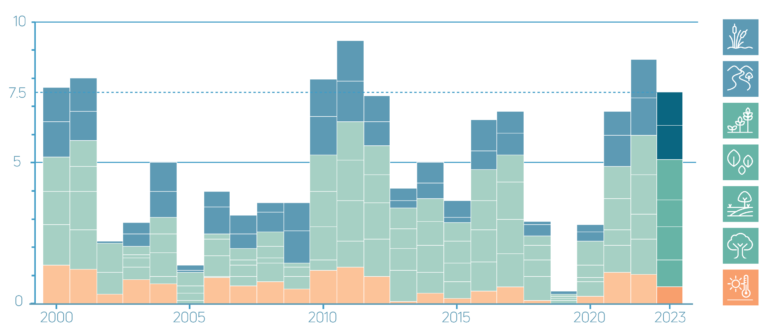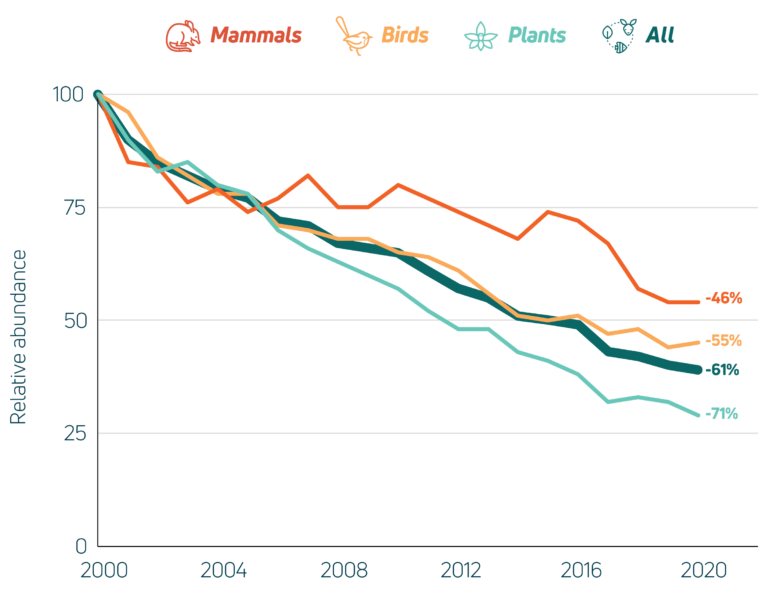A change from La Niña to El Niño climate patterns in the Pacific Ocean halfway through 2023 brought a change in Australia from wet to dry and warm weather and a decline in the measured environmental indicators, but overall environmental conditions remained well above average. However, a record 130 species were added to Australia’s List of Threatened Species, bringing the total number of threatened species to 2,098.
Produced each year since 2015 through a collaboration between TERN and the Australian National University (ANU), the Australia’s Environment report is an account of the environmental trajectory of the nation, recording key events and challenges that define the Australian landscape and determine its future resilience.
Released on 19 March 2024 in Canberra, the Australia’s Environment 2023 report records a slight worsening of the nation’s environmental conditions compared to the previous year, with an Environmental Condition Score of 7.5 out of 10 – but nevertheless indicative of a relatively healthy environment.

Environmental condition scores declined in all Australian states and territories – except for the Northern Territory. The Northern Territory’s environmental condition score climbed to 8.8, an improvement of 3.5 compared with its very low score in 2022 of 5.3.
Environmental conditions swinging from wet to dry and back
The report reveals that 2023 stood as the eighth hottest year on record for Australia, a year that commenced with the lingering La Niña conditions, bringing wet weather and average temperatures. This provided relief to Northern Australia, which experienced a wet monsoon season after previous dry years.
However, the conditions shifted as the year progressed, with dry and unseasonably warm weather taking hold from May to October, leading to a decline in river flows, wetlands, and water reservoirs from their very high 2022 peaks, yet remaining above the long-term average.
The report’s lead author, ANU Professor Albert van Dijk said, “As always, there were regional differences. Northern Australia experienced the best rainfall and growth conditions in several years, also contributing to more than average grass fires during the dry season. On the other hand, Western Australia and Tasmania did not see the rain return and ended the year dry.”

The report also highlights the environmental contrast faced in December when very warm ocean temperatures east of Australia fuelled a cyclone and a series of storm systems, resulting in widespread flooding in Queensland and Victoria.
“Initially there were fears for a severe fire season, but this did not eventuate as the influence of the El Niño waned. Rainfall returned in November in part due to unusually warm oceans,” said Professor Albert Van Dijk.
Australia’s biodiversity continues to decline
The greatest threats to Australia’s Environment continue to be climate change, invasive species and habitat destruction. In a concerning trend, the number of threatened species surged, primarily due to the delayed effects of the catastrophic 2019/20 Black Summer bushfires.
Long-term monitoring data captured by TERN’s Threatened Species Index (TSX) revealed ongoing declines for Australia’s flora and fauna.
TERN’s TSX Project Coordinator, Tayla Lawrie said, “The latest results of the TSX indicate that threatened bird, mammals and plant populations have declined by 61% on average since the turn of the century.”
A major update to the index for threatened birds in 2023 revealed an average annual rate of decline of 2.8% since 2000. Declines were most severe for terrestrial birds (62%), followed by migratory shorebirds (47%) and marine birds (24%).

ANU Ecology Researcher, Shoshana Rapley said, “A record 130 species were added to the EPBC Act List of Threatened Species, bringing the total number of threatened species to 2,098 – a 47% increase since 2000.”
However, the latest TSX data again revealed that species protection and management can be an effective measure for slowing threatened species declines.
“We have evidence that conservation activities can work. The abundance of threatened plants at actively managed sites remains stable compared to 2000 values, whereas unmanaged populations continue to decline,” said Tayla Lawrie.
Long-term data monitoring the status of our environment
To produce the Australia’s Environment report and data explorer, ANU analyses vast amounts of long-term measurements from satellites and on-ground stations using algorithms and prediction models on a supercomputer, including many delivered by NCRIS-enabled projects, including TERN. The results allow patterns of change in Australia’s ecosystems to be assessed, which is critical to understanding and managing our environment.
Without the thousands of data sets gathered by citizen scientists, government, conservation and research groups and made available by TERN and its Threatened Species Index (TSX), Australia would be in the dark and unable to track the changes in abundance of its threatened and near-threatened species.
The Australia’s Environment report complements Australian Government State of the Environment reporting, allowing researchers and managers to monitor and analyse trends in the years between government State of the Environment report releases.
The Australia’s Environment 2023 report release event at the ANU Fenner School of Environment and Society







